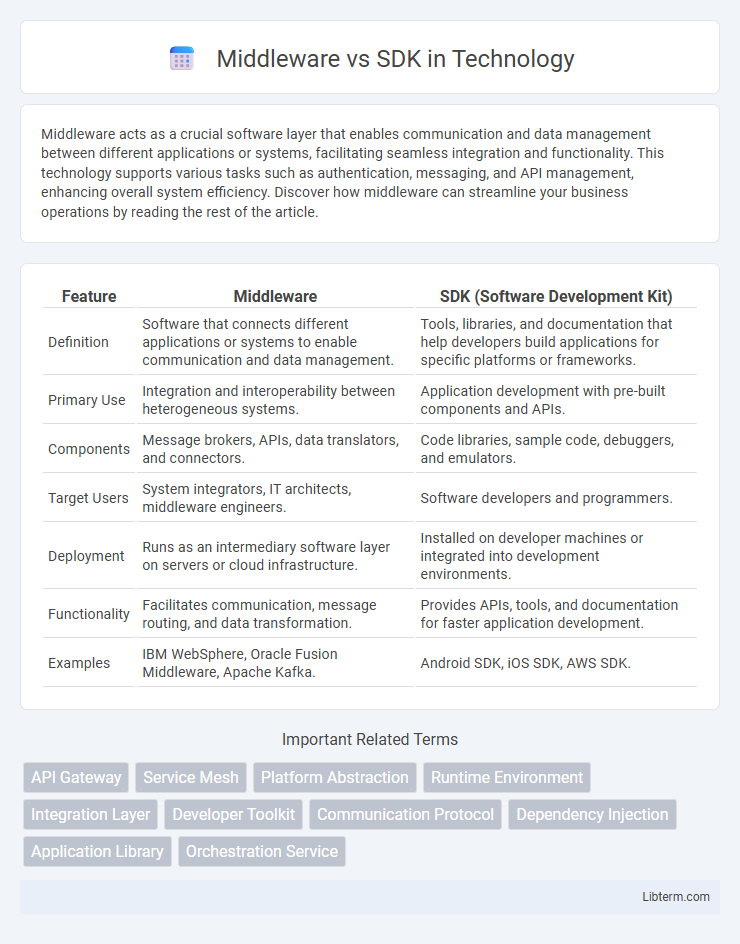Middleware acts as a crucial software layer that enables communication and data management between different applications or systems, facilitating seamless integration and functionality. This technology supports various tasks such as authentication, messaging, and API management, enhancing overall system efficiency. Discover how middleware can streamline your business operations by reading the rest of the article.
Table of Comparison
| Feature | Middleware | SDK (Software Development Kit) |
|---|---|---|
| Definition | Software that connects different applications or systems to enable communication and data management. | Tools, libraries, and documentation that help developers build applications for specific platforms or frameworks. |
| Primary Use | Integration and interoperability between heterogeneous systems. | Application development with pre-built components and APIs. |
| Components | Message brokers, APIs, data translators, and connectors. | Code libraries, sample code, debuggers, and emulators. |
| Target Users | System integrators, IT architects, middleware engineers. | Software developers and programmers. |
| Deployment | Runs as an intermediary software layer on servers or cloud infrastructure. | Installed on developer machines or integrated into development environments. |
| Functionality | Facilitates communication, message routing, and data transformation. | Provides APIs, tools, and documentation for faster application development. |
| Examples | IBM WebSphere, Oracle Fusion Middleware, Apache Kafka. | Android SDK, iOS SDK, AWS SDK. |
Introduction to Middleware and SDK
Middleware functions as a software layer that facilitates communication and data management between applications and operating systems, enabling seamless integration and interoperability in complex systems. Software Development Kits (SDKs) provide developers with a collection of tools, libraries, documentation, and APIs designed to create applications for specific platforms or frameworks. Both middleware and SDKs play crucial roles in software development by enhancing functionality and streamlining the development process, but middleware primarily supports runtime interaction while SDKs focus on application creation.
Key Differences Between Middleware and SDK
Middleware acts as an intermediary software layer facilitating communication and data management between applications or systems, while an SDK (Software Development Kit) provides developers with a set of tools, libraries, and documentation to build specific applications or software components. Middleware operates at runtime to enable integration, whereas an SDK is used during the development process to create those integrations or applications. Middleware emphasizes interoperability and message brokering, whereas SDKs focus on offering APIs and reusable code to accelerate application development.
Core Functions of Middleware
Middleware primarily functions as an intermediary software that enables communication and data management between different applications or systems, facilitating seamless integration. It handles tasks such as message queuing, authentication, and API management to ensure efficient data exchange and system interoperability. Unlike SDKs, which provide development tools and libraries, middleware focuses on real-time connectivity and operational coordination across distributed environments.
Core Functions of SDK
SDKs provide comprehensive tools including libraries, documentation, and APIs that enable developers to build and integrate software applications efficiently. Core functions of an SDK encompass facilitating code development, debugging, and testing by offering pre-built components and standardized interfaces. Middleware, in contrast, primarily serves as a communication layer that connects different software systems without supplying extensive development resources.
Use Cases: When to Choose Middleware
Middleware is ideal for integrating disparate software systems and enabling communication between backend services in complex enterprise environments, especially when multiple applications require seamless data exchange. It excels in use cases such as connecting databases, messaging queues, and APIs without altering existing systems, providing a scalable, centralized communication layer. Choose middleware when orchestration, interoperability, and message routing across diverse platforms are critical to your architecture.
Use Cases: When to Choose SDK
SDKs are ideal for developers needing comprehensive tools to build applications within a specific platform or environment, providing pre-built libraries, APIs, and documentation to accelerate development. Use cases include creating mobile apps with iOS or Android SDKs, integrating third-party services like payment gateways, and deploying software on cloud platforms. Choosing an SDK ensures tight integration, faster time-to-market, and access to platform-specific features that middleware alone cannot provide.
Integration Challenges and Solutions
Middleware often faces integration challenges such as compatibility issues and data format mismatches between disparate systems, requiring robust APIs and protocol adapters for seamless connectivity. SDKs, while typically easier to integrate within specific platforms, may struggle with cross-platform interoperability and version inconsistencies, which can be addressed through comprehensive documentation and modular design. Both solutions benefit from standardized interfaces and automated testing tools to reduce integration friction and ensure consistent performance across diverse environments.
Performance and Scalability Considerations
Middleware often enhances system performance by efficiently managing communication and data exchange between distributed components, reducing latency and resource overhead. SDKs provide pre-built libraries and tools that streamline development but may introduce performance trade-offs depending on abstraction layers and integration complexity. Scalability benefits from middleware's ability to balance loads and facilitate modular expansion, while SDK scalability relies heavily on the adaptability of its APIs and compatibility with evolving platforms.
Security Implications: Middleware vs SDK
Middleware acts as an intermediary layer enabling secure communication and data exchange between different software components, often incorporating robust authentication, encryption, and access control mechanisms to safeguard sensitive information. SDKs provide developers with tools and libraries to build applications, embedding security features such as input validation, secure APIs, and cryptographic functions to mitigate vulnerabilities during development. The security implications of middleware emphasize protecting data in transit and integration points, while SDKs focus on secure code development practices and preventing exploitation at the application level.
Future Trends in Middleware and SDK Development
Future trends in middleware emphasize increased integration with AI and machine learning to enable smarter data processing and real-time analytics, supporting more adaptive and scalable applications. SDK development is moving towards enhanced cross-platform compatibility and comprehensive API support, enabling developers to build versatile applications with streamlined workflows. Emerging middleware solutions prioritize cloud-native architectures and microservices, facilitating seamless connectivity and efficient resource management across distributed systems.
Middleware Infographic

 libterm.com
libterm.com